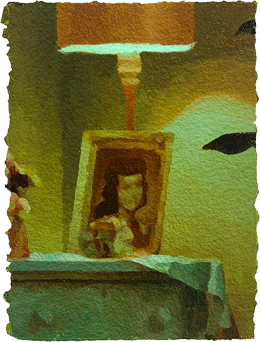Many a house is haunted, not by ghosts, but by those who call it home. They leave their traces everywhere, not as wisps and shadows, but in what they leave behind. Allow me to use the rest of this week in the quiet of summer for two posts that somehow slipped through the cracks this year and never made it online, both of the art of still life.
An empty room seems all the more haunting because nothing in it is alive—not the furnishings or the photograph on a table, the architecture or the paintings on the walls. The girl in a framed print might now be eternally young or eternally old. There is something of the past in her once fashionable dark curls and something of the present in a present generation’s love. At least there would be if one could only pin either of them down.
Tim Wilson does not make it easy, but then he is more interested in layers of sense and sensation than in answers. He sees his subjects as caught up in an “infinite regress of thought and meaning,” leaving it to him to “see them in context” and to “harness their meaning” in paint. If that sounds pretentious, he cannot help reflecting on what he sees and then reflecting on his reflections. What is their context? He is not letting on, but do not be surprised if it gets caught up in a regress, too. It is haunting all the same, at Nathalie Karg through April 15, and (together with a recent report on Susan Jane Walp and still life painting) it is also the subject of a longer review in my latest upload.
Wilson works on a modest scale that insists on how little he knows. It also places the work that much more between past and present. He works in oil on paper, mounted on panels. The ragged edges suggest fragments torn from something lost, but as objects in the gallery today. Close views fragment the interiors as well, leaving it to you to decipher the architecture and to know where you stand. He has plenty of lamps and mirrors, distorting or illuminating things, but I cannot swear that he ever shows the floor.
Dim light and lamp light keep things that much more at a distance. Unnatural colors recall the sepia prints of early photography, but in red, blue, or green. One work bathes a banister in red in front of yellow paneling and in proper perspective, but who knows where it leads? Scenes like these seem already history, with quaint furniture and quainter decor. Wilson closes in on a still life in an ornate frame, at once furniture within furniture and a painting within a painting. Just one work escapes the closed interior for a dark landscape that Jake Berthot or John Constable might have liked, but surely it, too, shows a painting.
 What of that promised context and meaning? Wilson has seen the missing inhabitants, but not where you might think. He starts with screen captures from TV. That explains the quaintness, the tinting, and the blur. They set him apart from the heightened reality of new media and the immediacy of Pop Art, where everything on earth is a commercial for something else. Wilson has long since turned off the set.
What of that promised context and meaning? Wilson has seen the missing inhabitants, but not where you might think. He starts with screen captures from TV. That explains the quaintness, the tinting, and the blur. They set him apart from the heightened reality of new media and the immediacy of Pop Art, where everything on earth is a commercial for something else. Wilson has long since turned off the set.
Still life has long been a matter of life and death. Dead animals and fruit past its prime served Dutch painting as allegories of vanity as much as displays of virtuosity. Andy Warhol has an obsession with reproducibility and death himself. Wilson’s infinite regress precludes allegory, and he changes everything by painting it, dead or alive. If everything is awfully stagy, such is television. If everything is also opaque, such is art.
Read more, now in a feature-length article on this site.
